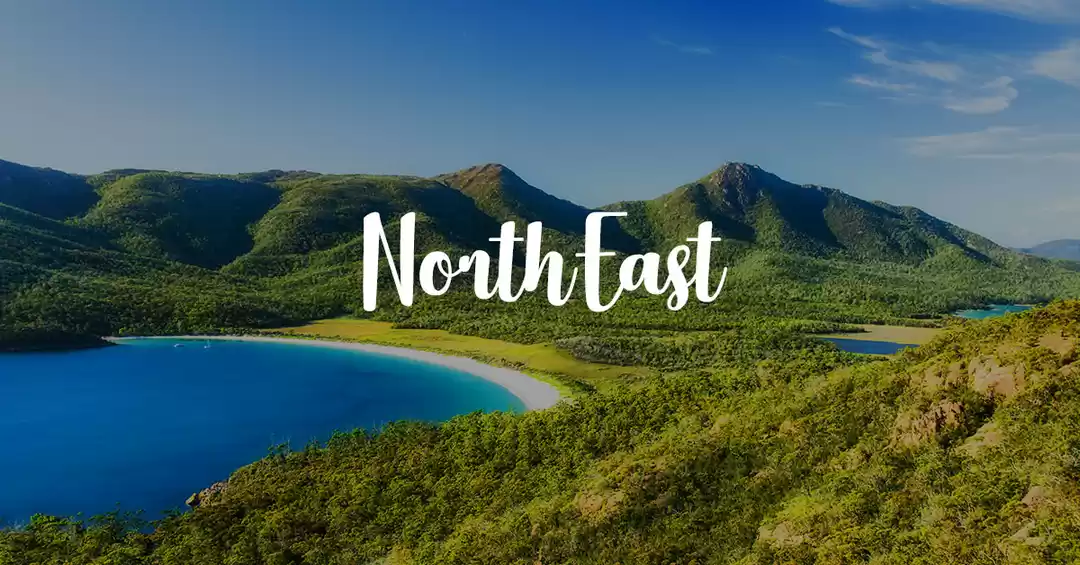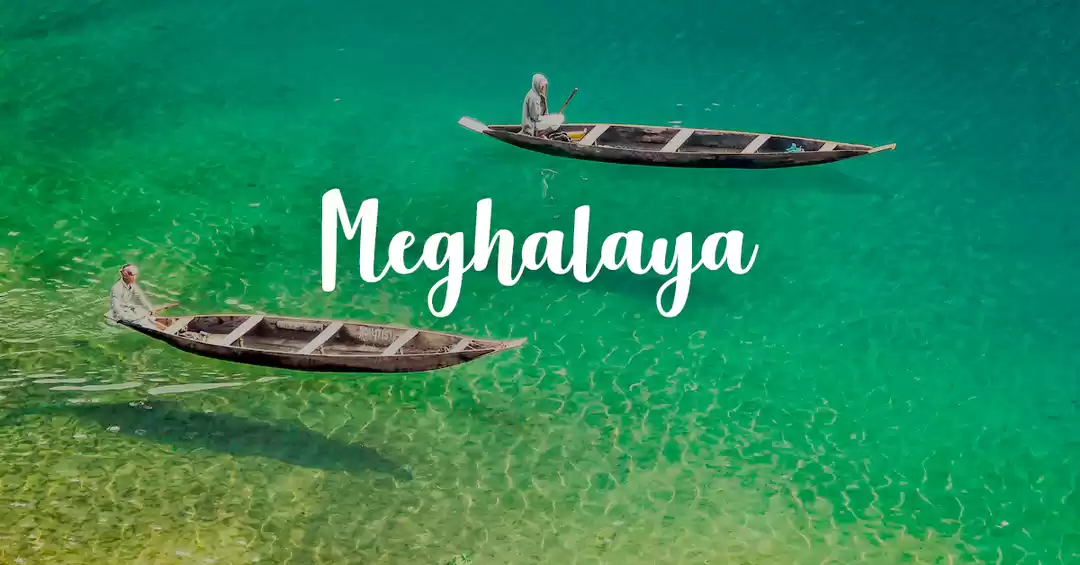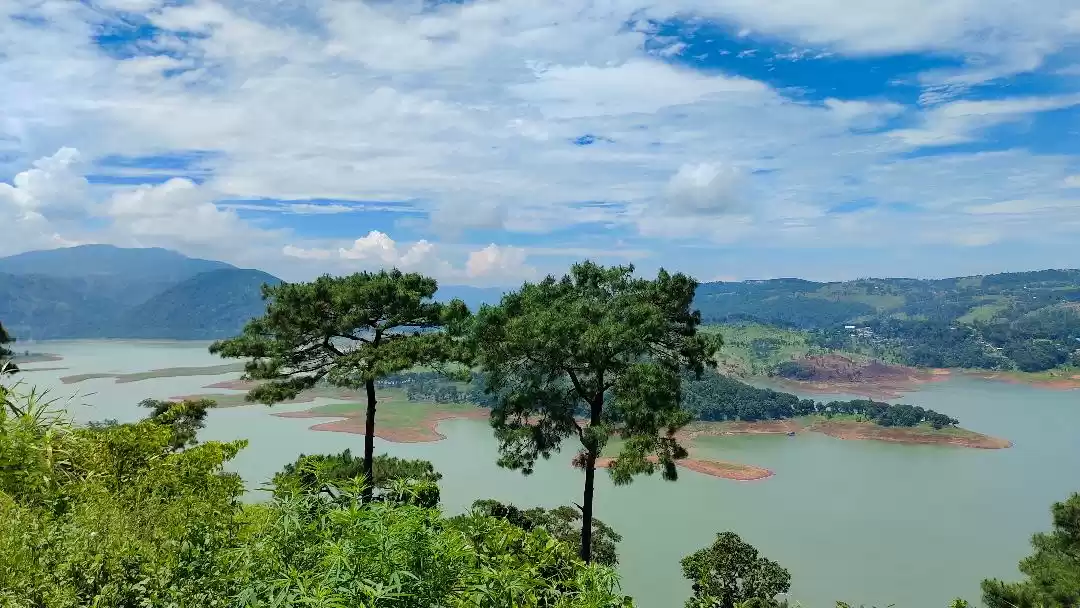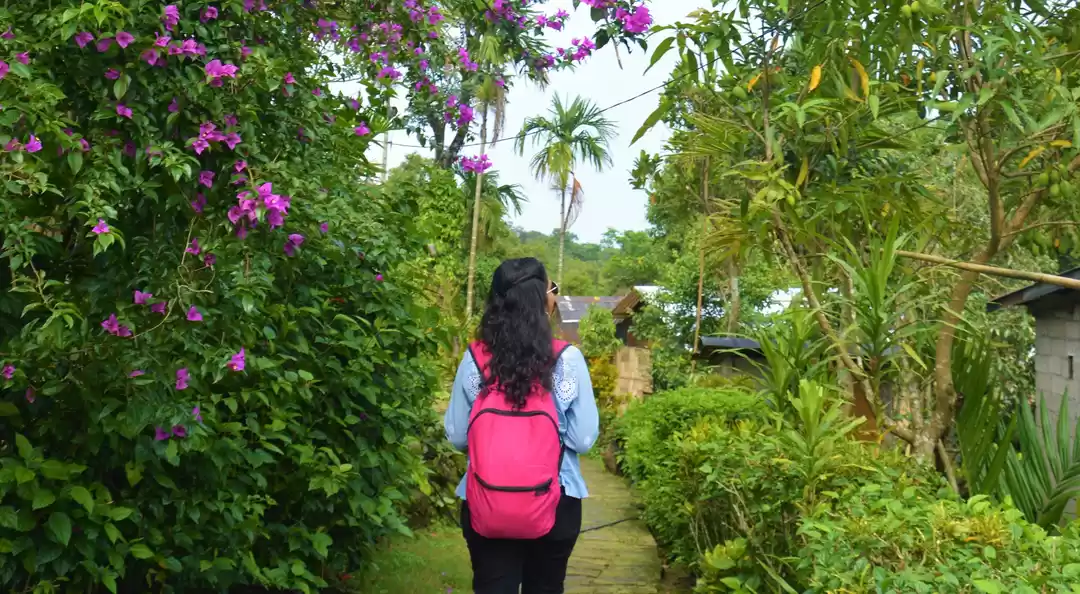
Mawlynnong is a small village in Meghalaya which is known for its cleanliness. The waste is collected in the dustbins made of bamboo, directed to a pit and then used as manure. A community initiative mandates that all residents should participate in cleaning up the village. Smoking and use of polythene is banned while rainwater harvesting is encouraged.
The travel magazine Discover India declared the village as the cleanest in Asia in 2003, and the cleanest in India in 2005. This reputation has boosted local tourism; in 2017 NPR reported that, according to the village headsman, incomes had increased by 60 percent due to increased tourism.
The road from Shillong winds over misty green hills towards the border post of Dawki. Clouds float into gorges below. Streams glisten like silver ribbons in the distance. Beyond the little town of Pynursla, there is a fork off this main road. The narrow village road becomes a corridor through a wall of green. Betel and broomstick plantations lean in from both sides. A short drive through this corridor brings one to Mawlynnong.
Pretty much the first thing in the village is the parking lot for the tourist vehicles. It is surrounded by little shops selling curios, and small and homely restaurants and tea shops run by locals.
Close to Mawlynnong is a bridge across a busy mountain stream built by intertwining the roots of a living rubber tree. It is one of two that are known to tourists, but there are more: may be there are hundreds. An American traveller, Patrick Rogers, who has trekked through the interiors of the state to map these bridges after becoming fascinated by what he calls “some of the world’s most unique architecture”, documented the existence of 88 of these remarkable structures in 2016.
They are practical, but also beautiful; they cost nothing to build, yet can render centuries of effective service; they are ancient, and yet could provide inspiration for dealing with a multitude of 21st century problems. No other form of architecture becomes naturally stronger over time, but as a root bridge is composed of living elements, so long as the tree it is a part of remains healthy, the structure will self-strengthen and continue to do so indefinitely.
Most of these bridges have no roads anywhere near, and can only be reached after long treks up and down hills. Meghalaya means “abode of clouds”. Unending rain and impenetrable fog are the typical conditions in which these treks would have to be undertaken.
I left the selfie-takers at the bridge to make my way back to Mawlynnong, where I met a young man named Sumer who took me on a walk around the village. This was the second village built on the site, Sumer said. The old village had burnt down in a great fire 70 or so years ago. The villagers had then moved to another spot but returned in a few years because this site had certain advantages. The place took its name from the Khasi words “maw”, meaning stone, and ‘lynnong’, meaning ‘scattered’, Sumer explained. Mawlynnong is scattered large rocks that have natural hollows in them. They were carved by flowing water at some time in the remote past.
At the edge of the village, on a ridge overlooking the plains of Bangladesh, there is a skywalk made of bamboo.
A slightly slippery walk up this in the rain took us to an observation deck of sorts, also made of bamboo, from where the land stretched green before us. Sumer even told me about the rare bioluminescent fungi that grow in the area during the rains when the conditions are right.
On the outskirts of the village lies a balancing rock, a must see nature's wonder for science freaks. Enclosed within a wired fence, the spot has two stones, a huge boulder resting on a smaller stone. The structure has remained like that for ages and no cyclone or storm has been able to disturb the formation. The place, which is surrounded by bamboo plantations, is called Nature's Balancing Rock or Maw Ryngkew Sharatia, locally.
While some elderly locals say that this was the spot where human sacrifices were made 1000 years back to appease the presiding deity of the area, the local guide Henry informs that it was an ancient shrine of the Khasi tribals that was no longer used after the advent of Christianity in Mawlynnong and Riwai. There is no entry fee to the spot and unlike the living root bridge, it can be easily accessible in a four-wheeler.
Khasis in Mawlynnong are devout Christians. Surrounded by orange and palm trees, stands a 100-year-old church in the village called 'Church of the Epiphany'. Narrow stone paths with plants bearing orange flowers reach out to the Church, which is a black and white structure exuding an old-world charm. There are no houses that rise above the Church spire.
According to history, Welsh Christian missionaries came to Mawlynnong in the 19th century from Bangladesh and since then, the village has been following a strong tradition of Christianity. The government website of Meghalaya reads that the village was initially known as 'Ri Kharpangkhat' and it got the name of Mawlynnong during the Christian mission of Rev. G A Jones. Mawlynnong, meaning a Cluster of Stones, was derived from the fact that there are numerous rocks in the village that have craters in them. Interestingly, villagers link the tradition of cleanliness to Christianity. They say it is the missionaries that changed their lives and taught them ways to reach God through cleanliness.

Day 1
The road from Shillong winds over misty green hills towards the border post of Dawki. Clouds float into gorges below. Streams glisten like silver ribbons in the distance. Beyond the little town of Pynursla, there is a fork off this main road. The narrow village road becomes a corridor through a wall of green. Betel and broomstick plantations lean in from both sides. A short drive through this corridor brings one to Mawlynnong.

Pretty much the first thing in the village is the parking lot for the tourist vehicles. It is surrounded by little shops selling curios, and small and homely restaurants and tea shops run by locals.
Close to Mawlynnong is a bridge across a busy mountain stream built by intertwining the roots of a living rubber tree. It is one of two that are known to tourists, but there are more: may be there are hundreds. An American traveller, Patrick Rogers, who has trekked through the interiors of the state to map these bridges after becoming fascinated by what he calls “some of the world’s most unique architecture”, documented the existence of 88 of these remarkable structures in 2016.

They are practical, but also beautiful; they cost nothing to build, yet can render centuries of effective service; they are ancient, and yet could provide inspiration for dealing with a multitude of 21st century problems. No other form of architecture becomes naturally stronger over time, but as a root bridge is composed of living elements, so long as the tree it is a part of remains healthy, the structure will self-strengthen and continue to do so indefinitely.
Most of these bridges have no roads anywhere near, and can only be reached after long treks up and down hills. Meghalaya means “abode of clouds”. Unending rain and impenetrable fog are the typical conditions in which these treks would have to be undertaken.
I left the selfie-takers at the bridge to make my way back to Mawlynnong, where I met a young man named Sumer who took me on a walk around the village. This was the second village built on the site, Sumer said. The old village had burnt down in a great fire 70 or so years ago. The villagers had then moved to another spot but returned in a few years because this site had certain advantages. The place took its name from the Khasi words “maw”, meaning stone, and ‘lynnong’, meaning ‘scattered’, Sumer explained. Mawlynnong is scattered large rocks that have natural hollows in them. They were carved by flowing water at some time in the remote past.
At the edge of the village, on a ridge overlooking the plains of Bangladesh, there is a skywalk made of bamboo.

A slightly slippery walk up this in the rain took us to an observation deck of sorts, also made of bamboo, from where the land stretched green before us. Sumer even told me about the rare bioluminescent fungi that grow in the area during the rains when the conditions are right.
Day 2
On the outskirts of the village lies a balancing rock, a must see nature's wonder for science freaks. Enclosed within a wired fence, the spot has two stones, a huge boulder resting on a smaller stone. The structure has remained like that for ages and no cyclone or storm has been able to disturb the formation. The place, which is surrounded by bamboo plantations, is called Nature's Balancing Rock or Maw Ryngkew Sharatia, locally.

While some elderly locals say that this was the spot where human sacrifices were made 1000 years back to appease the presiding deity of the area, the local guide Henry informs that it was an ancient shrine of the Khasi tribals that was no longer used after the advent of Christianity in Mawlynnong and Riwai. There is no entry fee to the spot and unlike the living root bridge, it can be easily accessible in a four-wheeler.
Khasis in Mawlynnong are devout Christians. Surrounded by orange and palm trees, stands a 100-year-old church in the village called 'Church of the Epiphany'. Narrow stone paths with plants bearing orange flowers reach out to the Church, which is a black and white structure exuding an old-world charm. There are no houses that rise above the Church spire.

According to history, Welsh Christian missionaries came to Mawlynnong in the 19th century from Bangladesh and since then, the village has been following a strong tradition of Christianity. The government website of Meghalaya reads that the village was initially known as 'Ri Kharpangkhat' and it got the name of Mawlynnong during the Christian mission of Rev. G A Jones. Mawlynnong, meaning a Cluster of Stones, was derived from the fact that there are numerous rocks in the village that have craters in them. Interestingly, villagers link the tradition of cleanliness to Christianity. They say it is the missionaries that changed their lives and taught them ways to reach God through cleanliness.
A short 2-day trip to Mawlynnong brings eternal peace to one's mind and body. After this trip, I felt as if life was like brewing tea ! We should boil our ego, evaporate our worries, dilute our sorrows, filter our mistakes and get the sweet taste of happiness. And this is what I learnt from the people f Mawlynnong. As we all know, every trip, big or small teaches us something or the other. :)

























